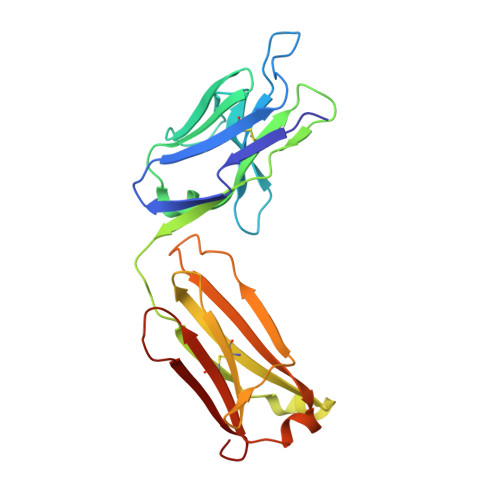Three-dimensional Structures of Idiotypically Related Fabs with Intermediate and High Affinity for Fluorescein.
Terzyan, S., Ramsland, P.A., Voss Jr., E.W., Herron, J.N., Edmundson, A.B.(2004) J Mol Biol 339: 1141-1151
- PubMed: 15178254
- DOI: https://doi.org/10.1016/j.jmb.2004.03.080
- Primary Citation of Related Structures:
1T66 - PubMed Abstract:
Multi-disciplinary studies of fluorescein-protein conjugates have led to the generation of a family of antibodies with common idiotypes and affinities for fluorescein ranging over five orders of magnitude. The high affinity 4-4-20 prototype traps the ligand in a highly complementary binding slot, which is lined by multiple aromatic side-chains. An antibody (9-40) of intermediate affinity belongs to the same idiotypic family as 4-4-20 and shares substantial amino acid identities within the VL and VH domains. To establish the structural basis for the affinity differences, we solved the crystal structure of the 9-40 Fab-fluorescein complex at a resolution of 2.3A. Similar to 4-4-20, 9-40 binds fluorescein in a tight aromatic slot with its xanthenonyl ring system accommodated by end-on insertion. However, the combined effects of the amino acid substitutions have resulted in reorganization of the binding site, with the HCDR3 loops showing the greatest differences in conformations. Access to the binding site of 9-40 is substantially more open, leaving the fluorescein's phenylcarboxylate moiety partially exposed to solvent. In addition to the usage of a different D (diversity) mini-gene encoding the HCDR3 loop, the decrease in fluorescein affinity in the 9-40 antibody family appears to be correlated with the substitution of histidine (9-40) for arginine (4-4-20) in position 34 of the antibody light chains.
Organizational Affiliation:
Crystallography Program, Oklahoma Medical Research Foundation, Oklahoma City, OK 73104, USA.
















